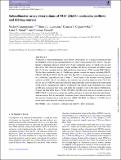Files in this item
Submillimeter array observations of NGC 2264-C : molecular outflows and driving sources
Item metadata
| dc.contributor.author | Cunningham, Nichol | |
| dc.contributor.author | Lumsden, Stuart L. | |
| dc.contributor.author | Cyganowski, Claudia Jane | |
| dc.contributor.author | Maud, Luke T. | |
| dc.contributor.author | Purcell, Cormac | |
| dc.date.accessioned | 2016-04-11T14:00:06Z | |
| dc.date.available | 2016-04-11T14:00:06Z | |
| dc.date.issued | 2016-05-11 | |
| dc.identifier | 241730899 | |
| dc.identifier | 32ad8477-e282-4a63-9763-69b3ca08c983 | |
| dc.identifier | 84963800317 | |
| dc.identifier | 000374569600048 | |
| dc.identifier.citation | Cunningham , N , Lumsden , S L , Cyganowski , C J , Maud , L T & Purcell , C 2016 , ' Submillimeter array observations of NGC 2264-C : molecular outflows and driving sources ' , Monthly Notices of the Royal Astronomical Society , vol. 458 , no. 2 , pp. 1742-1767 . https://doi.org/10.1093/mnras/stw359 | en |
| dc.identifier.issn | 0035-8711 | |
| dc.identifier.other | RIS: urn:8AF44BC7E0EF7A17F071203EF8518837 | |
| dc.identifier.uri | https://hdl.handle.net/10023/8595 | |
| dc.description | CJC was partially supported during this work by a National Science Foundation Astronomy and Astrophysics Postdoctoral Fellowship under award AST-1003134. | en |
| dc.description.abstract | We present 1.3 mm Submillimeter Array (SMA) observations at ∼3 arcsec resolution towards the brightest section of the intermediate/massive star-forming cluster NGC 2264-C. The millimetre continuum emission reveals ten 1.3 mm continuum peaks, of which four are new detections. The observed frequency range includes the known molecular jet/outflow tracer SiO (5−4), thus providing the first high-resolution observations of SiO towards NGC 2264-C. We also detect molecular lines of 12 additional species towards this region, including CH3CN, CH3OH, SO, H2CO, DCN, HC3N, and 12CO. The SiO (5−4) emission reveals the presence of two collimated, high-velocity (up to 30 km s−1 with respect to the systemic velocity) bipolar outflows in NGC 2264-C. In addition, the outflows are traced by emission from 12CO, SO, H2CO, and CH3OH. We find an evolutionary spread between cores residing in the same parent cloud. The two unambiguous outflows are driven by the brightest mm continuum cores, which are IR-dark, molecular line weak, and likely the youngest cores in the region. Furthermore, towards the Red MSX Source AFGL 989-IRS1, the IR-bright and most evolved source in NGC 2264-C, we observe no molecular outflow emission. A molecular line rich ridge feature, with no obvious directly associated continuum source, lies on the edge of a low-density cavity and may be formed from a wind driven by AFGL 989-IRS1. In addition, 229 GHz class I maser emission is detected towards this feature. | |
| dc.format.extent | 26 | |
| dc.format.extent | 6493687 | |
| dc.language.iso | eng | |
| dc.relation.ispartof | Monthly Notices of the Royal Astronomical Society | en |
| dc.subject | Stars: formation | en |
| dc.subject | ISM: jets and outflows | en |
| dc.subject | ISM: molecules | en |
| dc.subject | QB Astronomy | en |
| dc.subject | QC Physics | en |
| dc.subject | NDAS | en |
| dc.subject.lcc | QB | en |
| dc.subject.lcc | QC | en |
| dc.title | Submillimeter array observations of NGC 2264-C : molecular outflows and driving sources | en |
| dc.type | Journal article | en |
| dc.contributor.sponsor | Science & Technology Facilities Council | en |
| dc.contributor.institution | University of St Andrews. School of Physics and Astronomy | en |
| dc.identifier.doi | https://doi.org/10.1093/mnras/stw359 | |
| dc.description.status | Peer reviewed | en |
| dc.identifier.grantnumber | ST/M001296/1 | en |
This item appears in the following Collection(s)
Items in the St Andrews Research Repository are protected by copyright, with all rights reserved, unless otherwise indicated.

